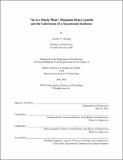| dc.contributor.advisor | Arindam Dutta and Mark Jarzombek. | en_US |
| dc.contributor.author | Chuong, Jennifer Y | en_US |
| dc.contributor.other | Massachusetts Institute of Technology. Dept. of Architecture. | en_US |
| dc.date.accessioned | 2012-09-11T17:26:55Z | |
| dc.date.available | 2012-09-11T17:26:55Z | |
| dc.date.copyright | 2012 | en_US |
| dc.date.issued | 2012 | en_US |
| dc.identifier.uri | http://hdl.handle.net/1721.1/72621 | |
| dc.description | Thesis (S.M.)--Massachusetts Institute of Technology, Dept. of Architecture, 2012. | en_US |
| dc.description | This electronic version was submitted by the student author. The certified thesis is available in the Institute Archives and Special Collections. | en_US |
| dc.description | Cataloged from student-submitted PDF version of thesis. | en_US |
| dc.description | Includes bibliographical references (p. [161]-164). | en_US |
| dc.description.abstract | This thesis suggests that architect Benjamin Henry Latrobe's engagement with American scientific discourses gave rise to a transitional aesthetics that radically refigured his European-derived notions of art and architecture. Looking at a range of works by Latrobe -- a selection of theoretical writings, the Essay on Landscape (a watercolor instruction manual, 1798-1799), and the Philadelphia Waterworks (1798-1801) -- I analyze his magpie borrowings of climate, geology, and natural history. These borrowings were sometimes awkward and were by no means uniformly successful; however, Latrobe's persistence in the face of failure underscores the importance he accorded to establishing, by any means possible, a mutual correspondence between nature, society, and art. Sometimes called "the father of American architecture," the British-born Latrobe (1764-1820) has generally been recognized for his large, nineteenth-century projects. Focusing on his financial and technical struggles around works like the US Capitol and the Baltimore Exchange, the prevailing historical narrative has emphasized the disjunct between the immigrant Latrobe's professional ambitions and the capabilities of the young American nation. In this thesis, I argue that an emphasis on Latrobe's embattled practice tells us little about the conceptual field that drove his work. More importantly, it ignores the ways in which a larger discursive and physical context transformed the architect's own understanding of his work and its function in a new democratic society. Recognizing, and valuing, the presence of nature in Latrobe's writings offers us a new way of understanding the architect's practice as one attuned to the prevailing physical and social concerns of the period. | en_US |
| dc.description.statementofresponsibility | by Jennifer Y. Chuong. | en_US |
| dc.format.extent | 164 p. | en_US |
| dc.language.iso | eng | en_US |
| dc.publisher | Massachusetts Institute of Technology | en_US |
| dc.rights | M.I.T. theses are protected by
copyright. They may be viewed from this source for any purpose, but
reproduction or distribution in any format is prohibited without written
permission. See provided URL for inquiries about permission. | en_US |
| dc.rights.uri | http://dspace.mit.edu/handle/1721.1/7582 | en_US |
| dc.subject | Architecture. | en_US |
| dc.title | "Art is a Hardy Plant:" : Benjamin Henry Latrobe and the cultivation of a transitional aesthetics | en_US |
| dc.type | Thesis | en_US |
| dc.description.degree | S.M. | en_US |
| dc.contributor.department | Massachusetts Institute of Technology. Department of Architecture | |
| dc.identifier.oclc | 805951233 | en_US |
